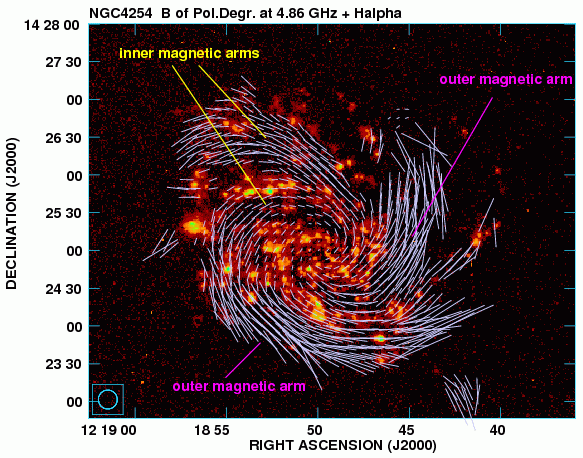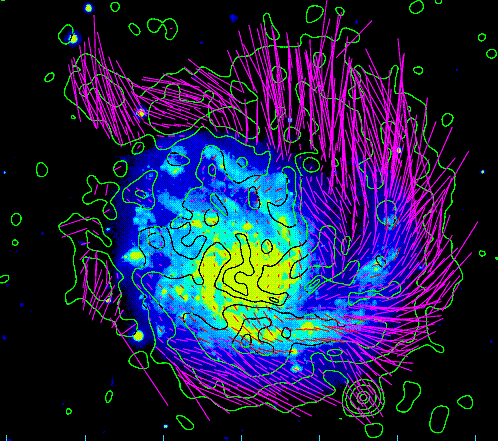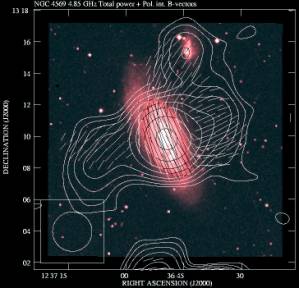 NGC4254 - magnetic field and Halpha emission in colours
NGC4254 - magnetic field and Halpha emission in coloursWe made high-resolution and high-sensitivity radio-polarimetric VLA observations of NGC 4254 at three frequencies (8.46, 4.86, and 1.43 GHz). The interferometric data were extended with single-dish (100-m Effelsberg) observations.
The distribution of total radio intensity at 8.46 GHz and 4.86 GHz reveals a global asymmetry with a more diffuse and almost two times larger extension to the north than to the south. The radio-polarized intensity is even more asymmetric, showing a strange bright ridge in the southern disk edge, displaced to the downstream side of the local density wave. Magnetic arms can also be seen in other disk portions, mostly (but not always) avoiding nearby optical spiral arms. (Chyy et al. 2007)
 NGC4254 - magnetic field and Halpha emission in colours
NGC4254 - magnetic field and Halpha emission in colours
 NGC4254 shows also extended, magnetized envelope at 1.4 GHz (21 cm).
NGC4254 shows also extended, magnetized envelope at 1.4 GHz (21 cm).
I developed an idea of magnetic maps for galaxies (Chyy 2008). They represent the patterns of total, regular, and random magnetic field strength for the whole galaxy, shown below in colors. The last panel (d) shows the field regularity, which is the ratio of the regular field to the random field. They all give the intrinsic values in the galactic disk, free of Faraday rotation and projection effects, basing on the data concerning galactic inclination, position angle of the galaxys major axis, distribution of total and polarized emission, and the local position angle of polarized emission. For a comparison, there are shown in the form of contours: HI, H-alpha, the infrared emission from the Spitzer satellite, and the UV emission from our XMM observations. As you can see, the total fields (a) reach locally 25 microG, so they are strong indeed as compared to other galaxies. This is probably related to the large star-formation rate for this spiral, which is about 7 solar masses per year. The random field (c) almost perfectly matches the mid-infrared emission. The regular field is also strong (b) and reaches up to 12 microG. This field is strong not just in the southern polarized ridge as expected, but also in the interarm region in the west. This enhancement is best visible in the field regularity. This regular field was partly hidden in the observed polarized emission because of projection effects. Thus the magnetic maps reveal structures that otherwise could be easily missed. This is very important for this galaxy when we ask for the origin of distorted magnetic structures. If the enhanced regular field in the south has been caused by the cluster ram-pressure and compressional forces, then that second region located deeply inside the galactic disk cannot be accounted for by the same effect. This provides an argument for the tidal origin of the modified magnetic field.

Magnetic maps enabled for the first time quantitative determination of relations between magnetic field components and the local density of star formation rate (SFR).

In the first figure (a) the total magnetic field strength is plotted against the SFR over more than 250 regions across the galaxy. The SFR is estimated from the mid-infrared emission. Different colors denote different spiral arms in the galaxy. The observed very high correlation is not unexpected as it represents the radio-infrared relation, plotted here locally for one galaxy. It shows that even in the perturbed cluster spiral with high SFR, the correlation is still there. The second figure (b) which shows the field regularity is even more interesting. Contrary to the total field, the field regularity strongly drops off in regions of stronger star formation. To further investigate this relation, I also present the strengths of random (c) and regular field (d) separately. The random field tightly correlates with SFR, while the regular one doesnt. Its quite surprising for the regular field to behave in a completely different way than the other magnetic field components. Such relations put new and strong constraints on the magnetic field generation process in galaxies.
The strong correlation of random field with SFR can suggest the effective production of random field in the star-forming regions as the principal cause. It can mean the operation of a small-scale dynamo in high SFR regions and a large-scale dynamo over the whole galactic disk. (Chyy 2008).
Using the Effelsberg radio telescope at 4.85 GHz and 8.35 GHz we discovered large symmetric lobes of polarized radio emission around the strongly Hi deficient Virgo cluster spiral galaxy NGC 4569. These lobes extend up to 24 kpc from the galactic disk. Our observations were complemented by 1.4 GHz continuum emission from existing Hi observations. This is the first time that such huge radio continuum lobes are observed in a cluster spiral galaxy. The eastern lobe seems detached and has a flat spectrum typical of in-situ cosmic ray electron acceleration. The western lobe is diffuse and possesses vertical magnetic fields over its whole volume. The lobes are not powered by an AGN, but probably by a nuclear starburst that occurred ˜ 30 Myr ago, producing ≥ 105 supernovae. Since the radio lobes are symmetric, they resist ram pressure due to the galaxy's rapid motion within the intracluster medium (Chyy et al. 2006).
 NGC4569 - radio contours at 4.85 GHz (6cm), magnetic vectors and optical colorful image.
NGC4569 - radio contours at 4.85 GHz (6cm), magnetic vectors and optical colorful image.